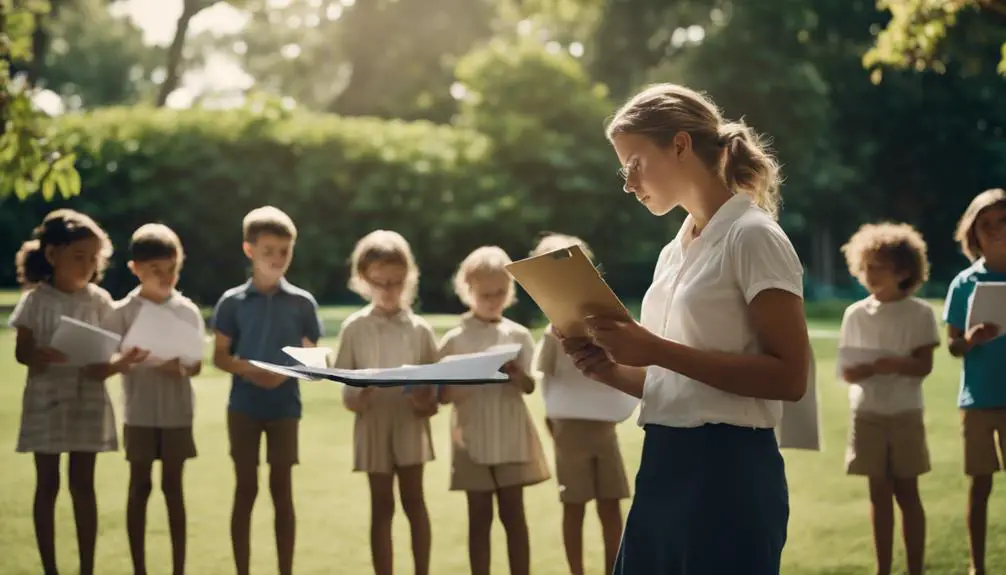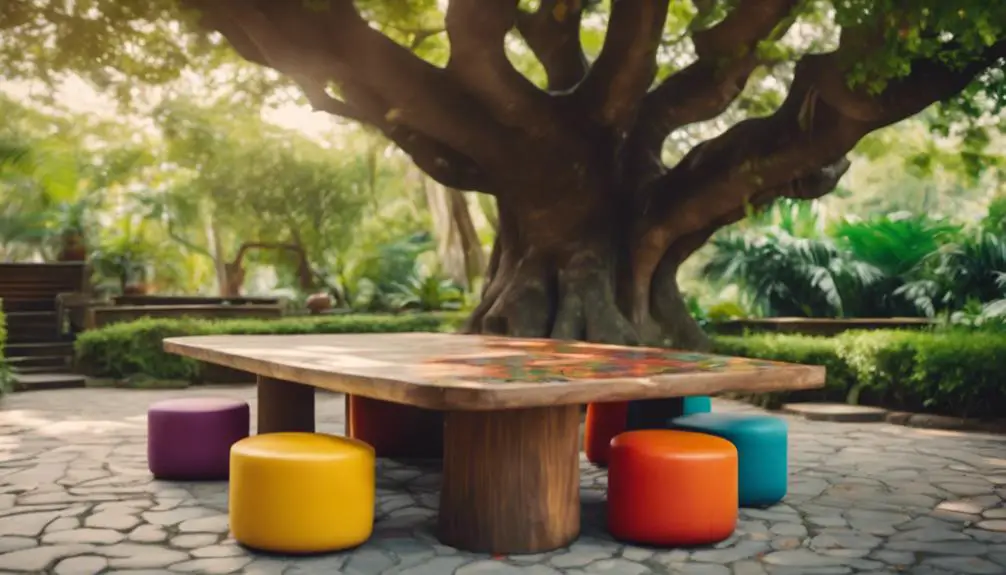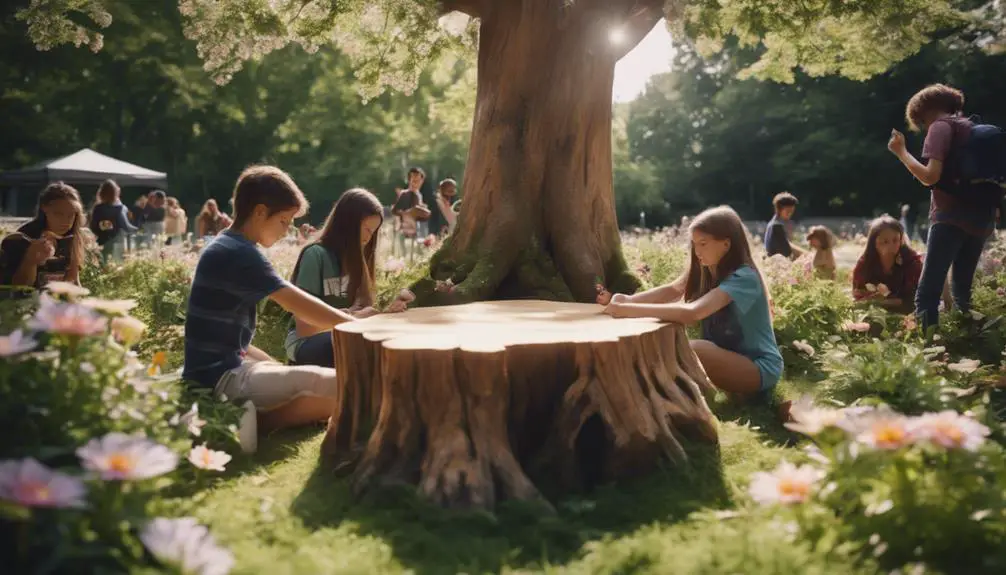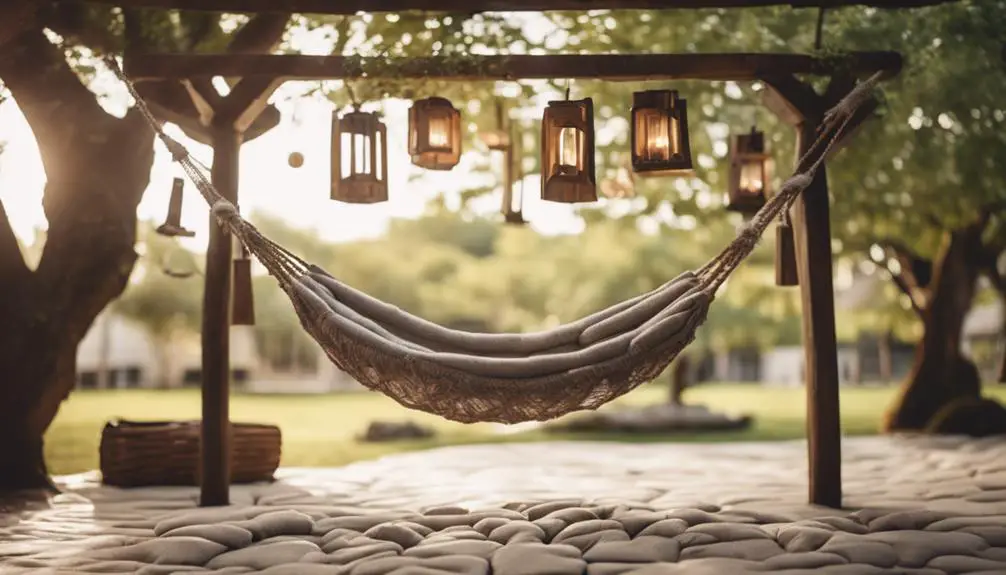As you start planning your outdoor learning space, you're likely wondering where to begin. You've got a blank slate – or maybe a neglected corner of the schoolyard – and a vision for a space that inspires curiosity and exploration. You'll need to weigh up the natural features of your area, from sunlight to existing structures, and define clear learning objectives to guide your design. But that's just the beginning. What comes next will make all the difference in creating an engaging, inclusive space that fosters immersive learning experiences. So, what are the essential elements you'll need to incorporate to bring your vision to life?
Assessing Your Outdoor Space

Take stock of your outdoor space by walking through it and observing the layout, noting areas that receive full sun, partial shade, and full shade, as well as any existing features like gardens, trees, or structures.
This initial assessment will help you identify site constraints that may impact your outdoor learning space design. Make a mental note of any obstacles, such as uneven terrain, poor drainage, or existing infrastructure that can't be moved.
Next, create a space inventory by cataloging the natural and built features that already exist in your outdoor space. This includes plants, trees, benches, and any other elements that could be repurposed or incorporated into your design.
Consider how these features can be leveraged to support your learning objectives, or if they need to be adapted or removed. By understanding your site's unique characteristics, you'll be able to design an outdoor learning space that not only complements its surroundings but also maximizes its potential for innovation and exploration.
Defining Learning Objectives

As you envision your outdoor learning space, take a moment to pinpoint what you want students to achieve in this natural setting.
What skills or knowledge do you want them to gain, and how will you measure success?
Clear Objectives Defined
By defining clear learning objectives, you'll create a roadmap for your outdoor learning space, guaranteeing that every activity and lesson aligns with your educational goals and values.
This vital step helps you determine the learning outcomes you want students to achieve, making it easier to design engaging and effective lessons. To start, review your curriculum and identify the key concepts and skills you want to focus on.
Then, break down each objective into specific, measurable, and achievable targets. For instance, if you're teaching environmental science, your objective might be to have students understand the water cycle and its impact on ecosystems.
By doing so, you'll guarantee curriculum alignment and create a clear direction for your outdoor learning space.
As you define your objectives, consider the unique opportunities an outdoor setting provides.
How can you leverage the natural environment to enhance learning? Perhaps you'll use nature-based activities to foster critical thinking, creativity, or problem-solving skills.
Outdoor Classroom Goals
Defining outdoor classroom goals involves pinpointing the specific skills and knowledge you want students to acquire in your outdoor learning space, ensuring that every activity and lesson stays focused on achieving those objectives.
As you envision your outdoor classroom, think about what you want students to take away from their experiences. Do you want them to develop a deeper appreciation for nature? Improve their scientific inquiry skills? Enhance their creativity through outdoor art projects?
Whatever your objectives, make sure they align with your learning standards and curriculum requirements.
When setting outdoor goals, consider the unique opportunities your outdoor space provides. For example, if you have a garden or a nearby park, you may want to focus on environmental education, conservation, or sustainability.
If you have a natural playground or outdoor art installations, you may want to emphasize creative expression, problem-solving, or social-emotional learning.
Choosing a Theme or Focus

As you envision your outdoor learning space, you'll want to decide on a unifying theme or focus that ties everything together.
You might opt for a nature-inspired learning area, where natural elements like trees, rocks, and water features take center stage, or design an outdoor classroom concept that incorporates intentional learning zones.
Nature-Inspired Learning Areas
Imagine yourself standing in a serene forest, surrounded by towering trees, where the sounds of chirping birds and rustling leaves create a sense of wonder, and envision how you can replicate this atmosphere in your outdoor learning space by choosing a nature-inspired theme that sparks curiosity and exploration.
A nature-inspired theme can transport students to a world of discovery, where they can explore and learn in a unique and engaging way.
Consider incorporating elements of forest floors, such as wooden benches or natural stone pathways, to create a sense of connection with the natural world.
You can also incorporate Wildscapes, like native plants or a small pond, to bring the outdoors in.
This won't only create a visually stunning environment but also provide opportunities for hands-on learning and exploration.
Outdoor Classroom Concepts
Envision your outdoor learning space transformed into a vibrant ecosystem where students can thrive, and choose a theme or focus that resonates with your educational goals and the surrounding environment.
As you conceptualize your outdoor classroom, consider the type of outdoor exploration you want to facilitate. Will it be a nature-based STEM lab, a habitat restoration project, or a sensory garden for environmental immersion? Perhaps it's a combination of these concepts.
Whatever your vision, establishing a clear direction is crucial to define a clear theme or focus to guide your design and programming decisions.
When selecting a theme, think about the local flora and fauna, as well as the unique features of your site.
For instance, if you're near a water source, you might create a wetland exploration area. If you have a wooded area, consider a forest ecology focus.
By choosing a theme that honors the natural environment, you'll create an immersive and engaging outdoor classroom that inspires students to learn, explore, and connect with nature.
Selecting Essential Furniture

You'll need to prioritize functionality and comfort when choosing essential furniture for your outdoor learning space, opting for pieces that can withstand the elements while fostering collaboration and creativity.
Consider durable, weather-resistant materials like recycled plastic, sustainably sourced wood, or powder-coated metal that can brave the sun, rain, and wind.
For outdoor comfort, incorporate seating options with built-in cushions or add plush outdoor pillows to encourage learners to linger and engage.
Look for furniture with ergonomic design, like curved benches or adjustable tables, to promote comfort and reduce fatigue.
Additionally, choose multi-functional pieces, such as storage benches or modular tables, to maximize space and versatility.
Don't forget to incorporate natural elements, like planters or a living wall, to bring the outdoors in and create a calming atmosphere.
Incorporating Technology Outdoors

As you design your outdoor learning space, integrate technology that's specifically engineered to thrive in outdoor environments, such as weather-resistant tablets, solar-powered charging stations, and wireless speakers that can withstand the elements.
This will enable you to create an immersive and engaging learning experience for your students.
Imagine using digital chalkboards to bring lessons to life, or taking virtual fieldtrips to explore remote locations without leaving the outdoor space.
These innovative tools won't only enhance student engagement but also provide a unique opportunity to connect with nature while learning.
By incorporating eco-friendly technology, you'll reduce your carbon footprint and create a sustainable learning environment.
When selecting outdoor technology, consider the durability and weather resistance of each device.
Look for products with rugged designs, waterproof coatings, and long-lasting batteries.
By doing so, you'll guarantee that your outdoor learning space remains functional and effective, even in harsh weather conditions.
With the right technology, you'll be able to create a seamless learning experience that blurs the lines between indoor and outdoor education.
Ensuring Accessibility Features

Incorporate accessibility features into your outdoor learning space design to guarantee that every student can fully participate and engage with the natural environment, regardless of their abilities. You'll want to certify that your space is inclusive and welcoming to all students, including those with disabilities.
Start by designing accessible pathways that allow students with mobility impairments to navigate the space easily. Wide, smooth paths made of natural materials like wood chips or gravel are ideal. You should also consider installing ramps or gentle slopes to connect different areas of the outdoor space.
In addition to physical accessibility, consider sensory inclusivity. Incorporate a variety of textures, colors, and scents to create a rich and engaging environment. For example, you might include a sensory garden with plants that stimulate the senses, such as fragrant herbs or tactile succulents.
Designing for Safety Considerations

Designing your outdoor learning space with safety considerations in mind means carefully selecting materials and features that minimize hazards, from slip-resistant surfaces to secure storage for tools and equipment.
You'll want to conduct thorough risk assessments to identify potential hazards and develop strategies for hazard mitigation. Consider the age and abilities of your students, as well as the types of activities they'll be engaging in.
Choose durable, eco-friendly materials that can withstand the elements and heavy use. For example, opt for recycled rubber mulch or wood chips instead of gravel or sand, which can be hazardous for young children.
Install secure fencing and gates to prevent accidents and unwanted visitors. Verify that any water features, such as ponds or fountains, are safely contained and easily accessible for maintenance.
Don't forget to incorporate safety features into your storage solutions. Lockable cabinets and shelving units can keep tools and equipment out of reach of curious students.
Integrating Curriculum Outdoors

By taking your lesson plans outside, you'll create opportunities for students to engage with complex concepts in a more immersive, hands-on way, from measuring the water cycle in a rain garden to observing the life cycles of plants in a pollinator garden.
Outdoor exploration becomes a powerful tool for learning, allowing students to connect theoretical concepts to real-world experiences.
As you integrate curriculum outdoors, look for opportunities to make interdisciplinary connections.
For instance, a math lesson on geometry can become a hands-on exploration of spatial relationships in a garden's design.
Science lessons on ecosystems can be reinforced by observing the intricate relationships between plants and animals in a wildlife habitat.
By making these connections, you'll help students see the world as a cohesive, interconnected system, rather than isolated subjects.
Take advantage of the outdoor space to incorporate project-based learning, where students can design and implement their own experiments or projects that span multiple subjects.
This approach not only deepens their understanding of complex concepts but also fosters critical thinking, creativity, and problem-solving skills.
Creating a Comfortable Atmosphere

As you design your outdoor learning space, you're not just creating a spot for students to sit – you're crafting an environment that fosters engagement and focus.
To do this, you'll want to ponder the sensory details that'll make your students feel comfortable and at ease.
Seating Options Matter
You'll want to choose seating options that not only provide comfort but also foster a sense of connection to nature, such as recycled plastic benches or tree stumps adorned with plush cushions.
These unique seating options will encourage students to engage with the outdoors while promoting a sense of calm and focus.
Consider incorporating flexible benches that can be rearranged to accommodate different learning activities, from group discussions to individual reflection.
Collaborative lounges with built-in planters can also bring the outdoors in, blurring the lines between nature and classroom.
Look for materials that are durable, low-maintenance, and sustainable, such as FSC-certified wood or repurposed materials.
By selecting seating that thoughtfully integrates with the natural environment, you'll create an outdoor learning space that inspires curiosity and creativity.
As you design your space, remember that the right seating can make all the difference in fostering a love of learning and a connection to the natural world.
Soft Fabrics and Textures
Vibrant hues and tactile textures bring warmth and coziness to your outdoor learning space, inviting students to settle in and engage with the natural world around them.
To create a comfortable atmosphere, you'll want to incorporate soft fabrics and textures that complement your seating options. Consider adding plush outdoor pillows, soft blankets, and natural fiber rugs to define cozy corners.
These elements will make your outdoor space feel like a serene oasis, perfect for focused learning and relaxation.
When selecting textiles, opt for eco-friendly, water-resistant materials that can withstand the elements. You can also repurpose old fabric scraps or upcycle vintage textiles to add a unique touch to your space.
Soft landscaping elements, like a living wall or a lush green roof, can also contribute to a cozy ambiance.
Nature-Inspired Color Schemes
By thoughtfully selecting a nature-inspired color scheme, you can create a harmonious atmosphere that mirrors the serenity of the outdoors, drawing students in and fostering a deeper connection with the natural world.
Earth tones, such as sage green, sandy beige, and weathered wood, bring a sense of calm and stability to your outdoor learning space. These muted hues also provide a subtle backdrop for incorporating pops of color through botanical-inspired accents, like vibrant flowers or lush foliage.
To take your color scheme to the next level, consider incorporating botanical hues that evoke the natural world. Shades like mossy stone, leafy green, and sky blue can add a touch of whimsy and wonder to your outdoor space.
You can incorporate these colors through furniture, planters, or even decorative accents like throw pillows or rugs. By thoughtfully selecting a nature-inspired color scheme, you'll create an outdoor learning space that feels immersive, engaging, and connected to the environment.
This, in turn, can inspire creativity, curiosity, and a love of learning in your students.
Adding Engaging Play Elements

Incorate natural materials and textures, like wooden logs, stone benches, and living walls, to create an immersive outdoor learning space that sparks curiosity and encourages exploration.
As you design your outdoor learning space, think about incorporating engaging play elements that will capture kids' attention and inspire learning.
One great option is play tunnels, which can be made from natural materials like bamboo or reclaimed wood. These tunnels provide a cozy, enclosed space for kids to crawl through, promoting physical activity and imagination.
Another idea is sensory walls, which can be created using natural materials like stone, wood, or plants. These walls offer a tactile experience, allowing kids to explore different textures and sensations.
You can also add interactive elements, like musical instruments or chimes, to create a multisensory experience.
Incorporating Nature and Wildlife

As you design your outdoor learning space, you'll want to ponder ways to attract local wildlife, such as butterflies, bees, and birds, by incorporating native plants, flowers, and trees that provide food and shelter.
This won't only create a thriving ecosystem but also provide endless opportunities for wildlife exploration and discovery.
Consider adding a birdbath or small pond to attract birds and insects, or planting a pollinator garden to support local bees.
To encourage students to engage with nature, incorporate nature journaling stations throughout the space.
Provide clipboards, pencils, and paper for students to record their observations, draw the wildlife they spot, and note the changes they see throughout the seasons.
You can also add a 'species of the month' board, where students can learn about and track the different wildlife that visit the space.
Establishing Rules and Expectations

Regularly, you'll need to revisit and refine the rules and expectations for your outdoor learning space to guarantee students understand how to respectfully interact with the natural environment and each other. This is vital in maintaining a positive and productive learning atmosphere. Establishing clear guidelines will help students develop good classroom etiquette, ensuring they respect boundaries and the outdoor space.
Start by creating a list of simple yet essential rules, such as staying on designated paths, not touching wildlife, and keeping noise levels down.
You can also designate specific areas for different activities, like a quiet zone for reading or a creative zone for art projects.
Make sure to communicate these rules clearly to your students and provide visual reminders, such as signs or posters, to reinforce the expectations.
Maintaining and Upkeeping Space

You'll need to schedule regular clean-up sessions with your students to maintain the outdoor learning space, guaranteeing it remains a vibrant and welcoming environment that fosters growth and exploration.
This can be as simple as assigning tasks such as picking up trash, watering plants, or wiping down surfaces.
Make it a habit to conduct space inspections regularly to identify areas that need attention, and involve your students in the process to instill a sense of ownership and responsibility.
Seasonal refreshes are also essential to keep the space fresh and engaging.
As the seasons change, update the space with new materials, plants, and activities that align with the current curriculum.
For example, in the spring, add new plant species or create a garden, while in the fall, incorporate fallen leaves into art projects or science experiments.
By doing so, you'll not only maintain the space but also create opportunities for cross-curricular learning and exploration.
Frequently Asked Questions
Can I Repurpose Existing Outdoor Structures for an Outdoor Learning Space?
You can breathe new life into existing outdoor structures, repurposing gazebos into vibrant outdoor classrooms. Imagine transforming a weathered pergola into a nature-inspired hub, where students can thrive amidst lush greenery and natural light.
How Do I Handle Inclement Weather in an Outdoor Learning Space?
You'll need weather alternatives and rainy day plans to guarantee learning continues uninterrupted. Consider installing retractable canopies, awnings, or using indoor-outdoor classrooms to shield students from the elements, while maintaining a connection to nature.
Are Outdoor Learning Spaces Only Suitable for Elementary School Students?
You wonder if outdoor learning spaces are only for elementary school students, but they're suitable for all ages, offering age-appropriateness and an expanded curriculum that fosters exploration, creativity, and connection with nature.
Can I Involve the Community in Designing and Maintaining the Space?
You can foster community connection by hosting outreach events, gathering feedback, and incorporating local expertise into the collaborative design process, ensuring your outdoor space reflects the community's vision and values.
Do Outdoor Learning Spaces Require Additional Staff or Training?
You'll need to assess staff ratios and consider hiring teacher mentors who specialize in outdoor education to guarantee a seamless shift. This will allow you to maximize learning potential while maintaining a safe and engaging environment.
Conclusion
As you step back to admire your new outdoor learning space, envision students exploring, discovering, and thriving amidst nature's beauty.
Your thoughtful design has created a vibrant hub for immersive learning experiences, where technology, accessibility, and safety blend seamlessly with the natural world.
With interactive elements, wildlife, and engaging play areas, you've crafted a space that inspires curiosity and fosters a deeper connection with the environment.




